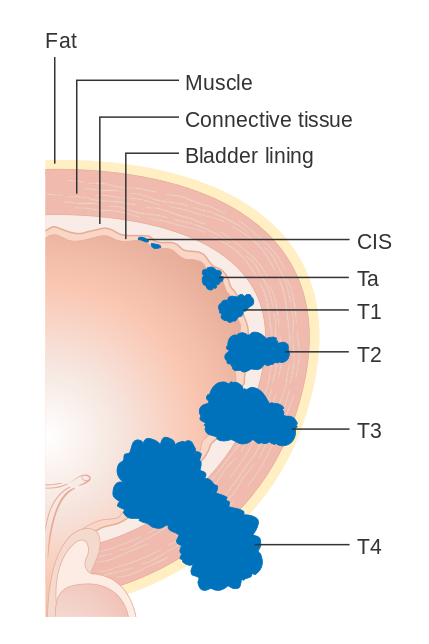Staging and grading bladder cancer
Staging and grading help doctors understand how advanced the bladder cancer is and how fast it may grow. This information guides treatment decisions and helps predict outcomes.
Staging and grading bladder cancer
Staging and grading give your medical team more information about your cancer and help them to plan the best treatment for you.
- Staging means finding out how deeply the cancer has grown into the bladder and if it has spread to other parts of your body.
- Grading describes how aggressive the cancer cells appear under the microscope.
Risk groups for non-muscle-invasive bladder cancer
- Non-muscle-invasive bladder cancer can be described as low risk, intermediate risk, high risk or very high risk.
- The risk group describes how likely the cancer is to return (recur) or to spread (progress).
- The risk group is worked out by looking at the stage and grade of the
cancer, as well as things such as the number of tumours and their
size. - The risk group may change over time.
The cancer is slower growing and less likely to spread or come back after treatment.
The cancer is faster growing and more likely to spread or come back after treatment than low-risk cancer.
The cancer is likely to grow quickly and spread or come back after treatment.
The cancer is very likely to come back after treatment or to spread and may require additional treatment.
If you have non-muscle-invasive bladder cancer, the risk group of the cancer is very important in deciding the best treatment and follow-up plan for you.
How is bladder cancer staged?
The staging system most often used in bladder cancer is called TNM.
It describes:
The size of the tumour and what layers of the bladder and nearby organs the cancer involves.
There are 4 lymph node stages in bladder cancer:
- N0 means there are no cancer cells in any lymph nodes
- N1 means there are cancer cells in one lymph node in the pelvis (between your hip bones)
- N2 means there are cancer cells in more than one lymph node in the pelvis
- N3 means there are cancer cells in one or more lymph node just outside the pelvis
M1 means the cancer has spread to other parts of your body and
M0 means it hasn’t. The organs most likely to be affected are your
bones, liver or lungs.
Number stages
Your doctor often uses this information to give your cancer a number stage. A higher number, such as stage 4, means the cancer has spread to other parts of the body. Some stages are further divided into stage A and B. In general, the lower the number, the less the cancer has spread.
Sometimes you may need surgery to find out the exact stage. This means that your treatment plan may only be decided or may change after you have had surgery.
Staging can be hard to understand, so ask your doctor and nurse for more information if you need it.
Staging non-muscle-invasive bladder cancer
Non-muscle-invasive bladder cancer is staged as follows:
- Carcinoma in situ (CIS): This appears as flat, red areas in your bladder. CIS is always classed as high grade because the cells are very abnormal and can grow quickly.
- Ta: Here the tumour is found as a mushroom-like growth (papillary cancer) growing only in the innermost lining of your bladder.
- T1: The tumour has started to grow into the connective tissue just below the bladder lining.

Image courtesy of CRUK / Wikimedia Commons
Staging muscle-invasive bladder cancer
Muscle-invasive bladder cancer is staged as follows:
- T2: The tumour has grown into the muscle layer in your bladder.
- T3: The tumour has spread through the muscle layer to the outer fat layer around your bladder.
- T4: The cancer has spread outside your bladder to other nearby organs, e.g. the prostate gland, womb, vagina or into the pelvic wall.
Advanced (metastatic) bladder cancer
Locally advanced bladder cancer means the cancer has spread to other nearby organs, e.g. the prostate, womb or vagina or in the nearby lymph nodes.
Bladder cancer that has spread beyond the surrounding areas, to other parts of your body such as the liver, bones or lungs is called advanced or metastatic bladder cancer.
What are the grades of bladder cancer?
Bladder cancer can be described as either low grade or high grade.
- Low-grade bladder cancer is less aggressive and less likely to grow, spread, or come back after treatment.
- High-grade tumours are more likely to grow, spread or come back after treatment. High-grade tumours are more likely to require further treatment after TURBT surgery.
Talk to a Cancer Nurse

Support Line
Our Daffodil Centres

